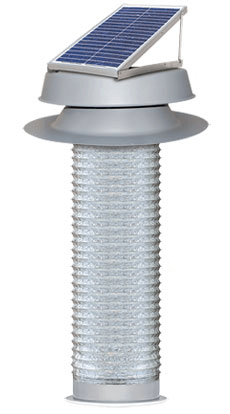Solar Attic Fans reduce heat build-up in your attic and can minimize the load on your HVAC system. Available for all roof types, solar attic fans install easily with no electrical wiring or structural changes and blend seamlessly into your roof line.

Solar Attic Fan is a simple and environmentally sensible solution that can protect your home and even save you money. Powered completely by free solar energy, this sleek and efficient attic vent is compact, quiet and powerful! Simply, the function of a solar attic fan is to improve attic air circulation resulting in a healthy, energy efficient home. Solar attic fans pull hot air and moisture out of your attic extending the life of your roof. In summer months, it keeps your attic cooler helping reduce the load on your HVAC system. In winter months, it prevents moisture build-up and ice damming. Our Solar Attic Fans are one of the best in their class with the highest standards for quality and functionality. We offer a Lifetime Limited Warranty – best in the industry.
The most obvious reason for attic ventilation is to lower the attic temperature during the warmer months. Attic temperatures can exceed 160°F during hot summer days. Proper attic ventilation can reduce those temperatures by up to 40°F. No matter how much insulation is in the attic, heat can still transfer into adjacent living spaces. In fact, extra insulation can actually add to temperature increases because heat is trapped in the insulation. Proper ventilation removes this excess heat build-up. As the heat is exhausted, the workload of your air conditioning system is reduced, thereby saving energy costs and even extending the life of your air conditioning system.
Though asphalt shingles are designed to take the abuse of the sun for many years, they are subjected to greater temperatures when the roof decking is allowed to overheat, which is just what happens in an under ventilated attic. In fact, asphalt shingle manufacturers warranties require proper attic ventilation. During the colder months, attic ventilation removes the warm, moist air that heat sources produce. Hot moist air lingering in the attic spaces can condense on the underside of the roof sheathing and rot it out. Moisture in the attic also causes mold to develop on the interior walls. Cold air in the attic space will not affect the temperature in the adjacent living spaces if properly insulated.
In the cooler months, moisture is the most serious concern. Even with the use of vapor barriers to keep moisture from entering the attic, there are air leaks around ceiling light fixtures, bathroom exhaust fans that allow unwanted moisture into the attic. Moisture condensing on the framing members and the inside of the roof deck can lead to the growth of mold, mildew and rot in the roof deck and framing. A good indicator of a moisture problem is rusty roof nails sticking through the roof deck.
Each model is available in 4 solar panel sizes: 16, 32, 48 and 65 watts. All other components are the same on all models. The solar panel on 60 watt units installed separately with a 15 feet wire pigtail; as well as all solar panels for the Gable Mount option.
The garage vent kit converts a roof or curb mount solar attic fan into a garage venting system. The kit can be added to all models sizes: 12, 24, or 36 watt.


The thermal snap switch is a small device which attaches to the attic fan motor designed to turn on the Solar Attic Fan when the temperature in the attic reaches approximately 80°F. The thermal switch will turn off the motor when the temperature in the attic reaches 70°F.

The optional Fire Safety Cutoff Switch is specially designed to help stop the spread of house attic fires during daytime fan operation by shutting down the fan. The switch features a fusible link that will melt at 228 degrees Fahrenheit to limit the introduction of fresh air that would otherwise help feed the fire. It is easily installed alone or in conjunction with the Thermal Switch.

Most solar attic fan installations on tile roofs need an additional flashing skirt. The custom designed flashing skirt is installed over the solar attic fan flashing to ensure a weather-tight installation. The steps to install a solar attic fan on tile roofs are slightly different than a standard installation.
